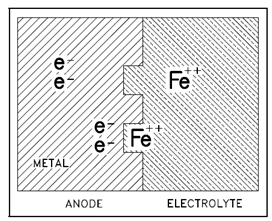Electrochemical Cells:
Corrosion is electrochemical in nature since the corrosive chemical reactions include transfer of charge. Below figure displays the transfer of charge while iron is in contact along with water or an acidic water solution.
Iron goes into solution as Fe++ ions. Since these ions go into solution then the metal becomes negatively charged (through the electrons left behind) along with respect to the electrolyte. A potential difference (voltage) is generated among the electrolyte and the metal. The procedure in that electrons are given up and positive metal ions are formed is known as oxidation. The sites at that the oxidation takes place on the surface of the metal become electrochemical cells made up of micro-electrodes of the two dissimilar substances; a metal and the electrolyte.
Those micro-electrodes set up several micro-cells linked by the bulk of the metal. It will go into solution to a greater (or lesser) if a different metal is used.

Figure: Formation of Ferrous (Fe++) Ions in the Corrosion of Iron
extent generating a larger (or smaller) potential difference among the metal and electrolyte than was the case for iron. For instance, magnesium and zinc go within solution to a greater extent than iron, and these metals will be more negative along with respect to an electrolyte than iron. Nickel, lead, and copper go into solution less readily and generates a smaller potential difference. Table 1 lists the potential differences for many metals in water. The sequence of the series could modify for different electrolytes (for instance, different pH, ions in solution).
Electrochemical cells and oxidation potentials are extremely important in understanding most corrosion processes. Instances of electrochemical cells involve galvanic cells (cells made up of electrodes of two different substances) and concentration cells (cells containing electrodes of the similar substance before different conditions of concentration).